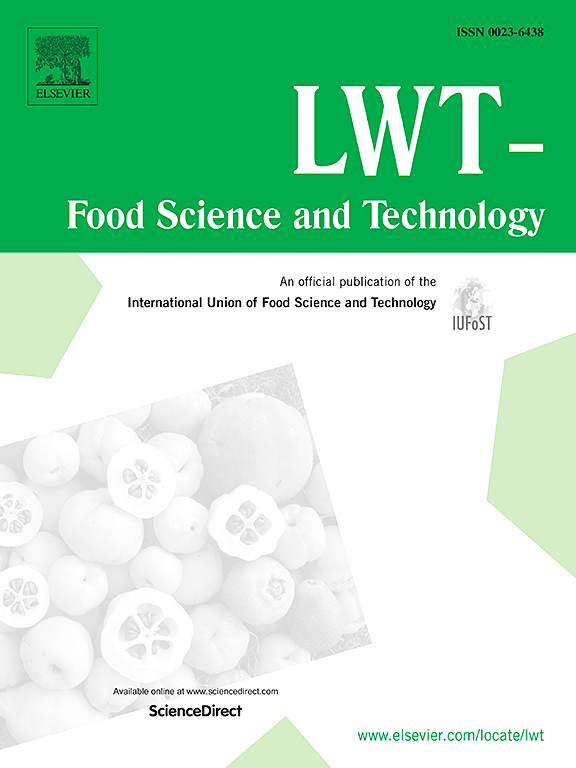通过模拟体外消化和结肠发酵评估山竹果皮原花青素提取物的抗氧化活性和益生元特性
IF 6.6
1区 农林科学
Q1 FOOD SCIENCE & TECHNOLOGY
引用次数: 0
摘要
山竹果皮原花青素提取物的生物活性与消化特性和结肠代谢有关。因此,本研究旨在探讨原花青素提取物在体外消化和结肠发酵过程中的动态变化、其对 PEC-J2 细胞氧化损伤的保护作用以及与肠道菌群的相互作用。结果表明,原花青素中含量最高的是表儿茶素和原花青素 B2。此外,儿茶素增加了 27.7 ± 0.2 μg/mL。山竹果皮的总酚含量、总黄酮含量和原花青素含量分别降低了 32.36%、90.63% 和 78.06%。但是,抗氧化能力却提高了两倍,从而保护细胞免受氧化损伤。未被胃肠道消化的原花青素聚合物会进入结肠,在那里被微生物代谢产生短链脂肪酸(SCFA)。原花青素提取物调节了微生物菌群结构:Phascolarctobacterium、Roseburia、Faecalibacterium、Coprococcu 和严格意义上的梭状芽孢杆菌的相对丰度都显著增加。乳酸菌与固醇菌的比例增加,双歧杆菌生长繁殖。这项研究提高了山竹果皮的利用率,并为科学评估山竹果皮的抗氧化活性和肠道微生物群调节作用提供了理论依据。本文章由计算机程序翻译,如有差异,请以英文原文为准。
Evaluation of the antioxidant activity and prebiotic properties of mangosteen peel proanthocyanidin extracts through simulated in vitro digestion and colonic fermentation
The biological activity of mangosteen peel proanthocyanidin extracts is related to digestive properties and colonic metabolism. Therefore, the study's aim was to investigate the dynamics of proanthocyanidin extracts during in vitro digestion and colonic fermentation, their protective effects against oxidative damage in PEC-J2 cells, and their interactions with the intestinal flora. The results showed that epicatechin and proanthocyanidin B2 were the most abundant in proanthocyanidin. In addition, the catechin was increased by 27.7 ± 0.2 μg/mL. The total phenol content, total flavonoid content, and proanthocyanidin content of mangosteen peel were reduced by 32.36%, 90.63%, and 78.06%, respectively. However, the antioxidant capacity was increased by two-fold, protecting against oxidative damage in cells. Proanthocyanidin polymers that are not digested by the gastrointestinal tract go to the colon, where they are metabolized by microorganisms to produce short-chain fatty acids (SCFAs). Proanthocyanidin extracts modulated the microbial flora structure: the relative abundance of Phascolarctobacterium, Roseburia, Faecalibacterium, Coprococcu, and Clostridium sensu stricto all increased significantly. The ratio of Bacteroides to Firmicutes increased, and Bifidobacterium grew and multiplied. This study improves the utilization of mangosteen peel and provides a theoretical basis for the scientific evaluation of the antioxidant activity and gut microbiota modulation of mangosteen peel.
求助全文
通过发布文献求助,成功后即可免费获取论文全文。
去求助
来源期刊

LWT - Food Science and Technology
工程技术-食品科技
CiteScore
11.80
自引率
6.70%
发文量
1724
审稿时长
65 days
期刊介绍:
LWT - Food Science and Technology is an international journal that publishes innovative papers in the fields of food chemistry, biochemistry, microbiology, technology and nutrition. The work described should be innovative either in the approach or in the methods used. The significance of the results either for the science community or for the food industry must also be specified. Contributions written in English are welcomed in the form of review articles, short reviews, research papers, and research notes. Papers featuring animal trials and cell cultures are outside the scope of the journal and will not be considered for publication.
 求助内容:
求助内容: 应助结果提醒方式:
应助结果提醒方式:


